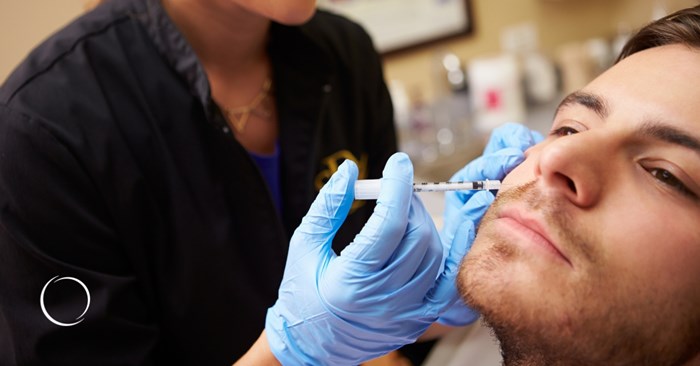What not to do after getting facial filler

Facial fillers can help add volume and fullness to your face, giving you the perfect pout or enhancing the contours of your cheeks. These popular injectables can also smooth lines, reshape the nose and give patients a more balanced facial appearance.
While it may seem like today's fillers can do almost anything, you can't. That is to say, there are things that you should avoid immediately after getting facial filler so that your body has time to recover and your filler has time to settle.
Understanding what to avoid after your filler appointment can help prevent complications and side effects, such as swelling and discomfort.
What to avoid after your facial filler injections
Fillers can boost volume and bust wrinkles, but if you don't follow your plastic surgeon's instructions, you can compromise healing and your overall result. Exposing newly treated areas to heat or pressure can interfere with the healing process and compromise results.
Anureet Bajaj, MD, breaks down the basics of what not to do after getting facial filler:
- Avoid aspirin and/or NSAIDS for five to seven days before and 24 to 48 hours after to help decrease the risk of bruising
- Avoid alcohol, if possible, during this time frame for the same reason
- Avoid exercise or strenuous activity for 24 hours to decrease the risk of bruising/swelling
- Avoid excessive heat, like a sauna, for 24 to 48 hours to decrease the risk of swelling as well
She also recommended that patients avoid the massage table for 24 to 48 hours after getting filler to help decrease the risk of filler migration. If you need a little rest and relaxation or are planning to get filler as part of a "girls' weekend" or spa retreat, consider doing the massage portion of your itinerary before any filler or other injectable procedures.
"Aggressively massaging can also result in filler migration, so it's best to avoid this as well," said Dr. Bajaj.
That means do not massage, poke, prod or otherwise disturb your treatment area. Discomfort or swelling may have you itching to touch or rub the injection area, but avoid aggressively massaging or touching your face.
Swelling is one of the most noticeable side effects of filler treatments that can concern a patient.
"What patients probably notice is that since filler is a hydrophilic product and acts like a sponge, with any trauma or nearby procedure or even with extra salt intake or flying at high altitudes, they may notice that the filler holds onto water more than the surrounding tissues and can cause some temporary swelling," said Kristy Hamilton, MD. "Once the root cause of the inflammation is addressed, the look of the filler would normalize."
Understand that mild swelling is normal and will go down as your body heals.
"I tell patients they are generally looking back to normal by three days – could be even sooner – but may require up to three weeks to fully let the filler 'settle,'" said Dr. Hamilton.
Worried that you scheduled a dental appointment right after an injectable procedure?
"There's no need to wait for a dental appointment beyond a few days after injection," said Dr. Hamilton. "Filler should not impact any future activities once the patient has recovered from the initial treatment."
Other things that you should avoid after getting filler, which can impede healing or cause discomfort, include:
- Smoking and nicotine products
- Prolonged sun exposure without protection or sunscreen
- Facial products, skincare or makeup with "active" ingredients that may irritate sensitive skin
- Other noninvasive plastic surgery procedures, such as laser treatments, microneedling and microdermabrasion
As with all plastic surgery procedures, invasive or not, tell your doctor about any medications or supplements you take before treatment. Some drugs, like blood thinners, can increase the risk of bruising.
Things you should do after getting facial filler
Don't let the list of "don'ts" prevent you from pursuing a procedure you are interested in. There are ways to mitigate the pain, bruising and swelling of injectable fillers. Dr. Bajaj recommended:
- Take a Zyrtec beforehand to decrease swelling (can also take the day after)
- Take two Tylenol beforehand (will help with pain and discomfort)
- Ice is your friend during the first 24 hours
Other steps you can take after getting filler to help make you more comfortable and promote healing include staying hydrated, drinking plenty of water and getting enough rest. Depending on the location of your filler, sleeping on your back to avoid putting pressure on the healing area is best.
"With any needle and injection, there is always the risk of bleeding (bruising), swelling and possible (but very unlikely) infection," said Dr. Hamilton. "Fillers are considered 'injectable implants,' so if the patient develops a facial infection at some point in the future, it would be possible that the filler, too, could become infected and possibly require dissolving to clear the infection."
Dr. Hamilton noted that these complications are rare. However, if a patient is concerned about bruising, swelling, pain or healing, talk to the plastic surgeon who injected the filler. Your doctor wants to help you achieve your desired result. Working with a board-certified plastic surgeon and taking proactive aftercare steps can promote longevity and prevent unwanted issues and complications, so your newfound volume doesn't fall flat.
To find a qualified plastic surgeon for any cosmetic or reconstructive procedure, consult a member of the American Society of Plastic Surgeons. All ASPS members are board certified by the American Board of Plastic Surgery, have completed an accredited plastic surgery training program, practice in accredited facilities and follow strict standards of safety and ethics. Find an ASPS member in your area.
